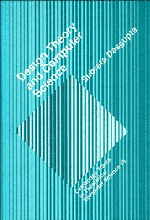Book contents
- Frontmatter
- Contents
- Preface
- Acknowledgements
- Part I The Architectonics of Design
- Part II Design Paradigms
- 6 The Concept of a Design Paradigm
- 7 The Analysis–Synthesis–Evaluation Paradigm
- 8 The Formal Design Paradigm
- 9 The Theory of Plausible Designs
- 10 Design and Artificial Intelligence
- 11 Algorithms for Design
- Part III Design and Science
- References
- Index
10 - Design and Artificial Intelligence
Published online by Cambridge University Press: 10 February 2010
- Frontmatter
- Contents
- Preface
- Acknowledgements
- Part I The Architectonics of Design
- Part II Design Paradigms
- 6 The Concept of a Design Paradigm
- 7 The Analysis–Synthesis–Evaluation Paradigm
- 8 The Formal Design Paradigm
- 9 The Theory of Plausible Designs
- 10 Design and Artificial Intelligence
- 11 Algorithms for Design
- Part III Design and Science
- References
- Index
Summary
THE AUTOMATION OF DESIGN
Thus far, the discussion of design paradigms has been basically devoted to the significance of design theory for computing systems design. Furthermore, the implicit focus has been on design as an intellectual, cogitative, human activity. In this and the next chapter I shall examine the obverse side of the coin – that is, the implications of computer science for design theory.
This is an issue that becomes rather relevant if we are interested in the automation of design. Specifically, we may ask the following types of questions: does the goal of automation cause us to expand our understanding of the design process (with respect to the architectonics discussed in Part I)? Given the desire to automate design, what are the characteristics of the relevant design paradigms?
The ‘classical’ response to the need to automate any task is to devise algorithms to perform the task. From a ‘classical’ perspective then, we are led to the algorithmic design paradigm. According to this paradigm, given a design problem one constructs algorithms that produce the design form. An algorithmic approach to design automation has the same kind of compelling appeal exhibited by the formal design paradigm: algorithms are formal, objective procedures with well defined, understandable behavioral characteristics. The problem with this paradigm is essentially twofold: firstly, the design problem must itself be sufficiently well-structured (see chapter 3, section 3.3) as to allow the algorithm to contain well defined conditions for its own termination; that is, in order to generate a solution to the design problem, the algorithm must ‘know’ what constitutes a solution and how to recognize the attainment of a solution.
- Type
- Chapter
- Information
- Design Theory and Computer Science , pp. 277 - 323Publisher: Cambridge University PressPrint publication year: 1991



